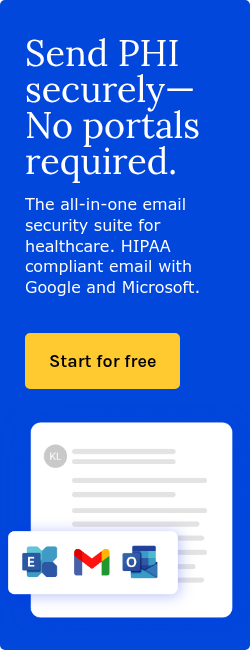3 min read
How to integrate email marketing with social media marketing practices
Kirsten Peremore
December 30, 2025

Through integrated strategies like cross-promotion; email marketing and social media can improve engagement and marketing effectiveness in healthcare organizations.
HIPAA and social media marketing
HIPAA’s Privacy Rule prohibits healthcare organizations from disclosing protected health information (PHI) without explicit patient authorization for social media marketing purposes. For example, posting a patient’s testimonial, photo, or case study on social media without a signed authorization would violate HIPAA. The Security Rule sets in place requirements in the form of Administrative Safeguards that provide protections for electronic PHI (ePHI). The requirements for staff training extend beyond traditional communication methods and can be extended to include social media communications.
It should be noted that organizations like the American Medical Association (AMA) provide more targeted guidelines on the use of social media. These include, “Physicians and medical students should be aware that they cannot realistically separate their personal and professional personas online and should curate their social media presence accordingly.” The AMA advises that physicians do the following:
- Consider that even personal social media posts can harm the professional reputation or the integrity of the profession.
- Respect patient privacy and confidentiality by not publishing patient information online without appropriate consent.
- Maintain appropriate boundaries in the patient-physician relationship on social media, following ethical guidelines.
- Use privacy settings to protect personal information but recognize that online content is likely permanent; regularly monitor social media presence for accuracy and appropriateness.
- Publicly disclose financial interests related to social media content, including paid partnerships and corporate sponsorships.
- Ensure that medical health care information shared on social media is accurate and useful, based on professional medical judgment.
The rules related to email marketing
Email marketing in a healthcare setting is governed by an interplay between HIPAA and the CAN-SPAM Act. HIPAA sets out the rules regarding the handling of PHI, including the requirement that all marketing communications as mentioned previously require authorization. For HIPAA compliant email marketing, it means that organizations have to ensure that patients are fully informed about the content of the emails they will receive and obtain a clear opt-in agreement.
CAN-SPAM Act adds requirements for healthcare marketing. An example of this is the need for commercial emails to include accurate sender information, a clear opt-out mechanism, and truthful subject lines. If an email is primarily promotional, it must comply with CAN-SPAM by providing recipients with an easy way to unsubscribe and honor these requests.
Examples of effective social media practices
- Healthcare organizations can share snippets or highlights from their email newsletter on social media to encourage followers to subscribe for more detailed information.
- Organizations can collect patient testimonials by email and then share them on social media. It showcases positive patient experiences and encourages others to participate in providing feedback.
- A healthcare provider could run an educational campaign on social media about specific health issues, directing followers to sign up for emails to provide in-depth resources and tips.
- When promoting health events or workshops, organizations can use social media to drive traffic to their email invitations.
- Healthcare organizations can use seasonal themes in both emails and social media posts like flu shot reminders in the fall. Social media can be used to generate awareness and excitement while email can provide specific details about availability.
How to integrate email marketing and social media marketing
Cross-promotion
- Include links to social media profiles in email footers or headers, inviting subscribers to follow for updates and community engagement.
Content sharing
- Share snippers or highlights from email newsletters on social media.
- Incorporate engaging social media content like videos or testimonials directly into email campaigns.
Use social media for list-building
- Add email signup forms directly on social media platforms like Facebook or Instagram. It allows users to subscribe without leaving the platform.
- Offer exclusive discounts or content in exchange for email sign-ups promoted through social media posts.
Analytics and insights
- Analyze engagement metrics from both platforms to refine marketing strategies. If certain topics perform well on social media they can be expanded upon in upcoming emails.
- Create a synchronized content calendar that aligns with social media posts.
FAQs
What are the consequences of violating CAN-SPAM?
The consequences of violating CAN-SPAM include:
- Financial penalties of up to $51,744 for each email in violation.
- Legal accountability for both the sender and the promoting company.
- Criminal charges can occur in severe cases.
What is the role of performance metrics in the effectiveness of social media campaigns?
Performance metrics help assess how well social media campaigns are achieving their goals and how strategies can be refined to better target audiences
.Can a healthcare provider share a patient's testimonial on social media?
Healthcare providers can share patient testimonials on social media if patient consent is obtained and they consider anonymizing the details of the patient's identity.
Subscribe to Paubox Weekly
Every Friday we'll bring you the most important news from Paubox. Our aim is to make you smarter, faster.




